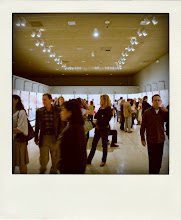More of today's questions answered by John Marciari, Curator of European Art and Head of Provenance Research at the San Diego Museum of Art
_______________
@JoseSPiano:
How often does –should?- a curator walk through the galleries and interact with the public once an exhibition has opened?John: I try to walk through all of my galleries, both the permanent collection galleries and those of temporary exhibitions for which I am responsible, every day. If something has happened to a work of art, the curator is most likely to spot it, so this is a good practice. It is also instructive (and occasionally amusing, and sometimes humbling) to hear what people say as they move through the galleries, so I sometimes will just sit on a bench and try to blend in. I don't necessarily interact with the visitors every day, but if someone seems to be confused or to have a particular question, I'll try to help out.
_______________@jbrunotte
Will it be a good idea to create an exhibition of art especially for children?John: This is a tricky one. On the one hand, the San Diego Museum of Art has since its beginning in 1926 had a biennial Young Art exhibition, in which works by students from grades K-12 are selected for display at the museum: this is an important contribution to local arts education and it introduces many local children to the Museum. So we're committed to programming and education for children. On the other hand, to plan a traditional travelling exhibition solely for children seems to me a bit narrowly focused. I'd say that a show like Heroes (which has been on view through the summer but closes after Labor Day) could be of equal interest to children or adults. That's a better use of resources.
________________@Karen5Lund:
Any curator: If you weren't a curator, what would be your other career choice?John: The obvious alternate career for most curators would be university professor. I, for one, have no desire to change.
_______________
@msbimia
What made you decide to become a curator?John: I grew up around paint and paintings, not so much because I went to museums, but in a more unusual way. As a young man, my father had worked for Bocour Artist Colors, one of the main producers in the US of artist paints, and he became great friends with Sam Golden, who was the great creative genius at Bocour: Sam was, for example, essentially the man who invented acrylic paint for artists. When Sam retired (for the first time - this is before he founded Golden Artist Colors a decade later), he moved to a farm in upstate New York where I spent many many weekends as a child. Sam and his wife Adele were like an extra set of grandparents to me. He was always telling stories about paint and painters (Morris Louis, Helen Frankenthaler, et al.) and as a result, I became interested in art. I took painting lessons for years when I was young (although no, I don't paint any longer). Later on, I went to college and became interested in European history (my undergraduate degree is in Classics), and then realized that I could combine that interest with the paintings by getting my doctorate in the history of art. Because I was always interested in paintings as physical objects-and for this I credit Sam and all those years of hearing about paint- I gravitated not to the university professorship that was the most obvious career path, but instead to curatorship, where I would always have the objects themselves as my primary focus. As I said in response to a question earlier today, there is nothing I'd rather be doing.
_______________@marplesmaples
What piece of art defines your museum?John: Our “defining piece of art” (if a museum can have one, or only one) is the great Still Life by Sanchez-Cotan. It's a masterpiece of still life painting and the best known work in the collection. It can stand as a symbol of our rich collection of old masters, particularly by Spanish and Italian artists.
_______________
@jaschaffer
Do you show work of up-and-coming artists, ones on the east coast?The Museum of Art serves as the encyclopedic museum for the San Diego region, and this includes shows by contemporary artists, including younger artists - although in the latter case, we're more inclined to focus on those with San Diego connections. The most recent example was our exhibition of Hugo Crosthwaite - his first museum show. Hugo now lives in New York, but he spent much time in San Diego.
_______________







